Banksia's for birdlife
The sight and sound of birds in the garden lifts the spirits and soothes the soul. Studies show that birdsong can even increase your property value. NZ tui, bellbirds and wax eyes have a sound all of their own, that most of us think extra special - something worth encouraging with the right kind of planting.
NZ native plants are popular bird magnets but our nectar seeking birds make no distinction between native and exotic trees when looking for food. They especially love Australia’s banksias, which flower mainly in winter when other food sources are scarce.
Banksia flowers are laden with sweet nectar. They also attract insects, a further winter food source for birds. The strikingly architectural flowers, which look fabulous in a vase, are produced in huge profusion for many weeks. Handsome banksias range from tall trees to low spreading shrubs and adapt to a wide range of conditions and are well known for their drought tolerance. They include some very useful shelter trees and many are ideally suited to coastal situations.
Look out for
- Banksia ‘Lemon Delicious’ is a compact hybrid with soft narrow leaves of vibrant bright green. Pretty lemon buds open to shades of gold and lemon. Flowering can be over a long period from late winter to summer. ‘Lemon Delicious’ adapts to a wide range of soils.
- Banksia ericafolia (heath banksia) from New South Wales was one of the original species collected by Joseph Banks in 1770. This bushy shrub is loved for its golden brown flowers and fine green foliage. Adaptable to many soil types, it responds well to pruning.
- Banksia ‘Giant Candles’ is a medium to tall shrub with exceptionally long flower spikes up to 40cm long. They are deep orange and appear during autumn and winter.
- Banksia grandis ‘Low Coastal’ is a select form ideal for coastal gardens. It has a low wide spreading growth habit with an abundance of large creamy yellow flower heads during late spring and summer.
Growing beautiful banksias
- Sun: Banksias thrive in a sunny open position.
- Soil: Most banksias prefer light sandy or gravelly soils, but some will cope with clay, provided excess water can drain away.
- Water: During the first two years after planting, support young plants with regular watering during dry spells. Once established most will tolerate long dry periods. However with reasonable rainfall over free draining soil they’ll thrive.
- Food: Opt for slow release fertilisers and feed very sparingly. Avoid high phosphorus fertilisers.
- Pruning: Prune each spring after flowering to maintain an attractive shape.
31-May-2014
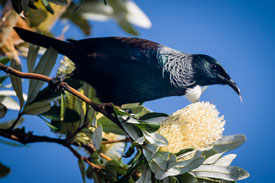
Tui feeding on Banksia
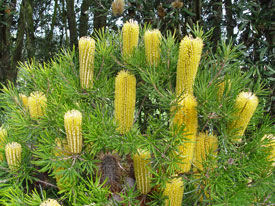
Banksia Lemon Delicious
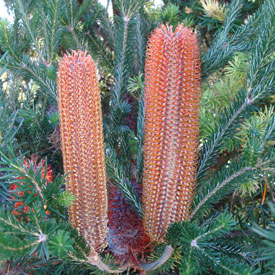
Banksia ericafolia
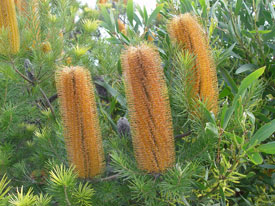
Banksia Gaint Candles
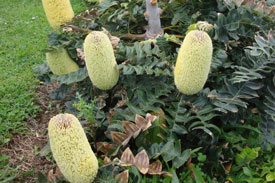
Banksia grandis Low Coastal



